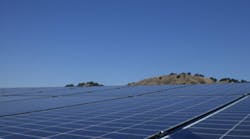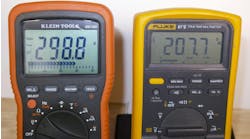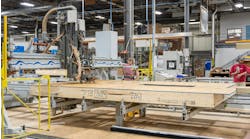Helped by federal mandates and state incentives, solar photovoltaic (PV) energy production is on the rise in the United States. The nation's domestic solar PV market grew from 220MW in 2007 to 357MW in 2008, according to MarketBuzz 2009, a report on the global PV market published by Solarbuzz, the San Francisco-based international solar energy research and consulting company. That same year, PV systems greater than 1MW comprised only approximately 59MW of the total market. As a result, in terms of number of installations, there were more than 60,000 distributed solar electric systems interconnected across the United States by the end of 2008, according to RNCOS, the Noida, India-based market research firm, which predicts the number of U.S. grid-tied PV installations will reach 100,000 by 2010 and 250,000 by 2015.
Unfortunately, this increase in the number of installations has created more opportunity for solar panel theft, which, according to a statistical study by SolarInsure, the Costa Mesa, Calif.-based independent insurance brokerage for the renewable energy industry, spiked 15% for commercial and residential installations from 2008 to 2009. Not surprisingly, reports of a surge in solar panel heists have come from California, the leading state for solar installations. For example, in 2009, more than 400 solar panels were taken from vineyards in Napa County, Calif. In fact, in the past few years, poachers have taken panels from schools, commercial enterprises, and traffic signal and sign posts throughout the state.
Outside of California, solar panel thefts remain less common. Nonetheless, some cases have been reported. In Oregon, for example, the highway department lost panels that powered portable traffic message boards. In Minnesota, the Sauk River Watershed District lost at least eight small panels worth $250 each.
“Theft has always occurred, but there are more arrays out there,” says Hugh Kuhn, Senior VP of engineering and technology and COO of Solar Power Partners, the Mill Valley, Calif.-based company that develops, owns, and operates distributed solar energy facilities and sells solar-generated electricity through solar power purchase agreements (PPAs). “It's not as if the ratio of modules stolen per modules installed is changing. Because there are more arrays out there, there are more opportunities to steal them.”
In plain site
Most panels are stolen from installations in remote areas or corporate parks empty on weekends. SolarInsure's statistical study reveals panels installed in remote areas account for more than one-third of solar thefts. “The ones we worry about the most are remote, so there's nothing you can do if thieves get in there,” says Kuhn of the solar electric systems his company owns and operates at schools, universities, municipalities, and special purpose districts, such as water districts.
Following remote locations, panels are also commonly stolen from unsecured locations, such as unfenced areas and parking lots. As such, ground-mounted systems — like those installed at the wineries — are more often targets for theft than rooftop systems. “Systems built on elevated structures are probably the safest,” Kuhn says.
In addition, tourist destinations and other scenic spots that desire public relations almost as much as the energy from the systems may sacrifice security by going without protective measures if they're unsightly or look unfriendly. “They like to show off the systems, so they don't put fences or alarms around them,” says Kuhn. “They put them in very exposed places without a lot of security around them because it looks bad, so they're very susceptible.”
The first step for an owner or installer to prevent solar panel theft, according to Kuhn, is to secure the perimeter, both for security and safety reasons. “All of our systems on the ground have fencing around them and other basic security measures,” notes Kuhn, meaning posted warning signs and security cameras or alarms as needed. “You've got to discourage people from even trying, and then make it difficult for them if they do.”
Under lock and key
There is a variety of security measures owners or installers can take to stop, or at least slow down, thieves. Minus any security measures, two burglars working together can dismantle a fairly large solar array and take off with around 50 panels in about an hour. “Putting them up takes some time,” says Gene Hunt, co-owner of Heliotex, Palm Desert, Calif. “Taking them down is simple.”
It doesn't help matters when installers don't follow installation recommendations. “Unfortunately, most module installers install the modules with just little clips on the edges, which just makes it too easy, as opposed to using the mounting holes in the back of the modules, which are the original intent,” says Kuhn. “You have one thing to knock off versus four or five.”
In the last few years, Hunt's company, Heliotex, known for making systems for washing solar panels, began selling customized stainless-steel nuts and bolts to lock the panels down. The fasteners fit the different types of solar rack assemblies and can be cut in a one-of-a-kind pattern, so regular wrenches and screwdrivers are useless against them. The installer or owner keeps the key needed to unfasten the hardware. “The beauty of that is, once you have it done, you've got the unique key that will fit that head design,” says Hunt. “It's a simple solution to a pretty big threat.”
The company only sells fasteners to either a licensed solar integrator company or a licensed electrician doing solar work. The charge for a unique design is $500 — or about $5 per bolt. “When you're looking at the thousands of dollars one invests in solar panels, spending a couple hundred bucks to make sure they stay there is a pretty cheap investment,” says Hunt, who compares the cost to the price of the deductible from an insurance company to cover one stolen panel.
The fastener system also is being offered by Bryce Fastener, Inc., of Gilbert, Ariz., which, for between $300 and $400 for a 50-panel system, offers keys with differing gradations of uniqueness — from one-of-a-kind to more generic in smaller quantities. Of the latter, Richard Bryce, owner, says the company investigates to make sure they go only to owners of solar systems. “We make sure they're not a retailer or somebody who wants to buy the bits to take out somebody else's system.” he says. “We monitor and limit the keys.”
Still, the fasteners aren't impossible to defeat. With enough time and determination, thieves could pry out the bolts or cut them with a hacksaw. Yet, with between 100 and 125 fasteners for a 50-panel solar system, they discourage would-be thieves altogether — or stall them long enough to get caught red-handed. “What they do is make the removal so difficult and time-consuming that a potential thief may decide it's not worth it,” says Hunt. “They have to cut the rack system apart to get at the panels and run the risk of damaged panels, because they can't get access to the fasteners.”
However, removable fasteners aren't appropriate for every application. In remote, vacant areas with large installations, meaning anywhere from 5,000 to 6,000 panels, fasteners with a unique lock would work well. In more populous areas and for some industrial applications, fasteners could be redundant.
Other manufacturers market breakaway bolts, which snap off while leaving the installation intact if someone attempts to unscrew them. But this arrangement poses problems for the person that ultimately needs to replace the panel.
Cause for alarm
For certain applications, such as smaller residential systems, installers may want to offer alarm systems to customers. There have been successful incidents of thieves caught after tripping an alarm. In September 2009, deputies responding to a 1 a.m. alarm at the solar panel field at the Napa Valley, Calif.-based Rutherford Vineyard arrested three men for attempted burglary, conspiracy to commit a felony, and possession of burglary tools.
Currently, Gridlock Solar Security, Santa Rosa, Calif., has developed an alarm system wired through each panel that sounds a 120 dB siren if a panel connection is disturbed. Simultaneously, the system dials up to eight preprogrammed numbers to notify the owner and police. The system costs $995 to $2,300, depending on the features, and is available to solar systems manufacturers for new systems as well as to system owners for retrofits.
However, many alarm systems are in their early stages. “Basically, you have solutions like running a wire through all the modules, and then if the wire gets cut you know that something's happened,” says Kuhn, who also lists other complex solutions, such as motion-sensitive cameras that use infrared or contain built-in analytics to analyze the images it captures. Furthermore, there are microwave perimeter detection systems and microwave fence vibration detection systems to detect if someone is cutting the fence around the system. “The motion of the cutting sets off a certain frequency vibration,” explains Kuhn.
Despite these varied options, the cost for these types of systems can be very high, making them an unrealistic option for the average array owner. However, in time, says Kuhn, modules themselves, imbued with intelligence, may act as their own alarms. “Modules will all be smart enough to know they've been stolen, and they'll just lobotomize themselves and no longer be useful,” he says. In this iteration, security finally will take advantage of the solar systems' electrical connection.
Consider the source
Speculation on the fate of the stolen panels varies. Some panels have been posted for sale on Craigslist — a $1,000 value in exchange for a few hundred dollars — and the perpetrators caught in sting operations, whereas some seem just to have disappeared. Some theories suggest Northern California marijuana growers are using them to go off-grid to hide their electricity use from the authorities.
In 2009, police in Chico, Calif., found 17 of the 46 solar panels stolen from Little Chico Creek School. An anonymous tip received after releasing images of the car and trailer allegedly used in the theft led investigators to the panels in a storage locker. Investigators said they are looking for the rest of the stolen panels, which might have been sold to unsuspecting customers. “There are rumors of people stealing them for off-grid use or to sell on a black market,” Kuhn says. “Some people were caught reselling them within their own business practice and have gone to jail.”
For this reason, installers must be vigilant regarding the source of the panels to be installed. The manufacturer or distributor of the panels should be able to provide the installer and owner with results from the flash test, which will confirm the module has just come from the supplier. “Definitely, if you're an installer, you should be buying your modules from a legitimate entity,” Kuhn says.
When in doubt about a module, check the California Energy Commission's (CEC's) list of approved materials. “You need to know that the module is UL-listed and approved by the CEC,” explains Dave Llorens, CEO and co-founder of San Francisco-based One Block Off the Grid (1BOG), a model for aggregate buying of solar power. “If it's on that list — and that list is pretty long — it's fine, and you should feel pretty good about it.”
Furthermore, in response to California's rash of solar panel theft, Rep. Mike Thompson, who represents Northern California, has added a provision to a bill that creates an updatable strategic roadmap to advance solar technologies through prioritized research, development, and demonstration activities. The provision would create a national registry for solar panel serial numbers that can be referred to in case of theft. The bill has been passed by the House of Representatives, and now awaits a Senate vote.
In the meantime, installers should map out the array by module serial number. In fact, some modules may even have the number on a bar code that can be scanned as they're installed. Otherwise, some companies, such as CodeSource, Denton, Texas, can scribe a bar code and serial number directly onto the module by using a laser. That way, the label won't fade in the sun. “If you're a smart owner, you have a record of all your serial numbers,” says Kuhn. “If you're really smart, you actually know where the serial number of every module is in every location in the array.”
Fortunately, there is no current legitimate market for used solar panels. “Until there's a legitimate secondary market, you won't see people stealing panels on a regular basis,” says Llorens. “There's no good way to sell stolen solar panels. They're expensive, but who can you sell them to unless you have your own company and put them on somebody else's roof? I don't think there's going to be a criminal racket that's going to do that.”
However, Llorens says there will undoubtedly be a secondary market for used solar panels within a few years, as people upgrade or return leased systems. Therefore, taking security measures now is extremely important.
Sidebar: On the Fence
In California, detectives assigned to investigate copper theft were among the first to notice missing solar panels. It seems that as the price of the scrap metal declines, the number of solar panel thefts increases. With copper bringing in less money, thieves look for other ways to earn ill-gotten revenue. Unfortunately, the relationship doesn't work in the inverse. In fact, a decline in the cost of solar panels may actually foster theft. As market penetration for solar power increases, so does a rise in solar panel theft. “The lower prices put them on more people's roofs, so there will be more available to steal,” says Dave Llorens, CEO and co-founder of San Francisco-based One Block Off the Grid (1BOG), a model for aggregate buying of solar power.
However, a lower price for the stolen panels may make some thieves think twice about risk. “If a 200W module sells for $400 retail, it might be worth $50 on the black market,” says Hugh Kuhn, senior VP of engineering and technology and COO of Solar Power Partners, the Mill Valley, Calif.-based company that develops, owns, and operates distributed solar energy facilities and sells solar-generated electricity through solar power purchase agreements (PPAs). “As the price comes down, the risk may outweigh the reward.”
In any event, solar panels, even during installation, must be protected from theft. In fact, some thieves have destroyed panels in the process of removing the wiring from them. “Protection also has to happen during construction, when it's easier to get into the copper,” says Kuhn.



